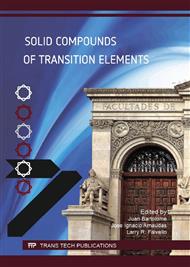[1]
E. Tomaszewicz, S.M. Kaczmarek, H. Fuks, New cadmium and rare-earth metal molybdates with scheelite-type structure, Mater. Chem. Phys. 122 (2010) 595–601.
DOI: 10.1016/j.matchemphys.2010.03.052
Google Scholar
[2]
P. Godlewska, E. Tomaszewicz, L. Macalik, J. Hanuza, M. Ptak, P. E. Tomaszewski, M. Maczka, P. Ropuszyńska-Robak, Correlation between the structural and spectroscopic parameters for Cd1−3xGd2xxMoO4 solid solutions where denotes cationic vacancies, Mater. Chem. Phys. 139 (2013).
DOI: 10.1016/j.matchemphys.2013.02.050
Google Scholar
[3]
E. Tomaszewicz, G. Dąbrowska, E. Filipek, H. Fuks, J. Typek, New scheelite-type Cd1-3xxGd2x(MoO4)1-3x(WO4)3x ceramics – their structure, thermal and magnetic properties, Ceram. Int. 42 (2016) 6673-6681.
DOI: 10.1016/j.ceramint.2016.01.024
Google Scholar
[4]
M. Guzik, E. Tomaszewicz, Y. Guyot, J. Legendziewicz, G. Boulon, Spectroscopic properties, concentration quenching and Yb3+ site occupations in a vacancied scheelite-type molybdates, J. Lumin. 169 (2016) 755-764.
DOI: 10.1016/j.jlumin.2015.02.043
Google Scholar
[5]
M. Guzik, E. Tomaszewicz, Y. Guyot, J. Legendziewicz, G. Boulon, Structural and spectroscopic characterizations of new Cd1-3xNd2xxMoO4 scheelite-type molybdates with vacancies as potential optical materials, J. Mat. Chem. C 3 (2015) 4057-4069.
DOI: 10.1039/c4tc02963a
Google Scholar
[6]
T. Groń, E. Tomaszewicz, M. Berkowski, H. Duda, Z. Kukuła, S. Pawlus, T. Mydlarz, T. Ostafin, J. Kusz, Dielectric and magnetic properties of CdMoO4: Gd3+ single crystal, J. Alloys Compd. 593 (2014) 230-234.
DOI: 10.1016/j.jallcom.2014.01.076
Google Scholar
[7]
P. Urbanowicz, M. Piątkowska, B. Sawicki, T. Groń, Z. Kukuła, E. Tomaszewicz, Dielectric properties of RE2W2O9 (RE = Pr, Sm–Gd) ceramics, J. Eur. Cer. Soc. 35 (2015) 4189–4193.
DOI: 10.1016/j.jeurceramsoc.2015.07.028
Google Scholar
[8]
P. Kubelka, F. Munk, Ein Beitrag zur Optik der Farbanstriche, Z. Tech. Phys. 12 (1931) 593–601.
Google Scholar
[9]
J.G. Simmons, Poole-Frenkel Effect and Schottky Effect in Metal-Insulator-Metal Systems, Phys. Rev. 155 (1967) 657-660.
DOI: 10.1103/physrev.155.657
Google Scholar
[10]
A. Von Hippel, Dielectrics and Waves, Artech House, London, (1995).
Google Scholar
[11]
A. Earnshaw, Introduction to Magnetochemistry, Academic Press, London and New York, (1968).
Google Scholar
[12]
T. Groń, E. Tomaszewicz, Z. Kukuła, S. Pawlus, B. Sawicki, Dielectric permittivity of some novel copper/cobalt and rare-earth metal tungstates, Mater. Sci. Eng. B 184 (2014) 14–17.
DOI: 10.1016/j.mseb.2014.01.006
Google Scholar
[13]
P. Urbanowicz, E. Tomaszewicz, T. Groń, H. Duda, S. Mazur, Z. Kukuła, S. Pawlus, T. Mydlarz, J. Krok-Kowalski, Electrical and magnetic properties of CuEu2W2O10 and Cu3Eu2W4O18, Solid State Phenom. 194 (2013) 104–107.
DOI: 10.4028/www.scientific.net/ssp.194.104
Google Scholar


